Hurdles to Distributing the COVID-19 Vaccine
- Xian Lan Zeng

- Dec 3, 2020
- 4 min read
Updated: Mar 10, 2021
While the world is racing to develop a working COVID-19 vaccine, uncertainties remain between development and vaccination. Currently, the United States is predicted to have tens of millions of vaccine doses distributed by mid-2021 under the government program Operation Warp Speed (Slaoui & Hepburn, 2020). However, one of the major concerns of vaccine distribution is how to equitably distribute vaccines. Countries that cannot afford vaccines often also have weak sanitation and vaccine distribution systems. Likewise, another major issue is how to transport vaccines safely and maximize vaccination rates. These issues, if left unresolved, will contribute to more unnecessary deaths.
Countries have been demonstrated to act on their own interests, which will prolong efforts to control the virus. For instance, during the 2009 H1N1 pandemic, countries such as the United States outbid other countries for access to the vaccine; countries prioritized vaccinating their own citizens first before donating vaccines to poorer countries (Weintraub et al., 2020). As with H1N1, many countries have already made deals to obtain vaccines from vaccine manufacturers. Distributing vaccines first for those who can afford them often neglects the populations in less wealthy countries more susceptible to the disease, resulting in additional unnecessary cases. In addition, less wealthy countries are less likely to cooperate with wealthier countries and share research findings crucial to developing vaccines out of fear that the benefits of their research will predominantly benefit wealthier countries (Bollyky et al., 2020). Due to this fear, potential treatments and vaccines developed in one country might not be shared with other countries who might benefit more. This nationalistic approach, worsened by economic inequities, ignores how COVID-19 is a global disease, infecting people of all backgrounds and influencing global economies. Not accommodating other countries’ needs will lead to COVID-19’s continued detriment to society because the virus will continue to spread among the unvaccinated, and prevent countries from recovering.
In addition to vaccine nationalism contributing to unfair distribution of vaccines, transporting vaccines from suppliers to patients also exposes inequities in countries’ logistics systems, as poorer countries are less capable of handling vaccines, and are more likely to waste vaccines.
Disparities in countries’ capability of handling vaccine distribution can hinder the global effort to vaccinate those at risk of contracting severe cases of COVID-19. The cold chain refers to the logistics of delivering temperature-sensitive products, such as vaccines, from manufacturers to users. In a review of ten African countries’ cold chains, the study’s authors emphasize how widespread issues, like prohibitive costs of new refrigeration equipment and limited access to equipment technicians, limit the quality of refrigeration (Ashok et al., 2017). Less wealthy countries, who tend to have limited, older cold chains, are less capable of providing vaccines for their populations because their outdated equipment often exposes vaccines to temperatures beyond the acceptable range. As a result, fewer effective vaccines can be administered in countries with limited cold chain capabilities, which increases the material and time costs needed to distribute enough vaccines. Furthermore, less wealthy countries with smaller cold chain systems like Burkina Faso also are struggling to obtain enough equipment to store the future influx of vaccines (Hinnant & Mednick, 2020). Less wealthy countries often are unaware of the number of equipment necessary to serve their populations and lack funding to purchase and maintain new cold chain equipment. Poor understanding of gaps in the cold chain may cause shipments of vaccines to be wasted if communities cannot handle the vaccines, increasing the time needed to vaccinate those communities.
Bridging over inequalities and cooperating between nations enables society to treat all lives fairly and better manage vaccination administration. For example, COVAX, a global partnership among countries and the World Health Organization, encourages its member countries to invest in its portfolio of vaccine candidates, and guarantees all member countries access to the vaccine if a vaccine works (Kuperfschmidt, 2020). This system lowers prices for less wealthy countries, making the vaccine more affordable for them. Therefore, countries can prioritize vaccinating the most vulnerable populations, limiting the spread of the virus. Meanwhile, the distribution of the vaccine can be optimized in countries with weaker cold chain logistics by conducting inventories of the current systems and providing funding for countries to upgrade their refrigeration equipment (Ashok et al., 2017). Improving awareness of problems in the cold chain system encourages countries to develop self-sustaining methods of delivering vaccines that can deliver vaccines to the underserved. These solutions target disadvantaged populations most, maximizing the number of lives saved.
For these solutions to work, countries need to collaborate and communicate their needs for vaccines. In the process, countries need to clarify where aid will be distributed first, and thus whose lives are prioritized. In addition, countries also need to determine the state of their distribution infrastructure, and begin the steps to inventory and upgrade equipment. While determining who should receive the vaccine first raises ethical issues, the pandemic provides the opportunity to determine a consistent, transparent vaccine distribution system that unifies the world. Planning an effective global response will prepare the world for future pandemics and reaffirm the intrinsic value of human lives.
References
Ashok, A., Brison, M., & LeTallec, Y. (2016, September 23). Improving cold chain systems: Challenges and solutions. Vaccine. https://www.sciencedirect.com/science/article/pii/S0264410X16307307?via=ihub.
Bollyky, T. J. (2020, June 23). The Equitable Distribution of COVID-19 Therapeutics and Vaccines. JAMA. https://jamanetwork.com/journals/jama/fullarticle/2765944.
Hinnant, L., & Mednick, S. (2020, October 19). Vaccine storage issues could leave 3B people without access. AP NEWS. https://apnews.com/article/virus-outbreak-pandemics-immunizations-epidemics-united-nations-fc4c536d62c5ef25152884adb1c14168.
Kupferschmidt, K. (2020, July 28). ‘Vaccine nationalism’ threatens global plan to distribute COVID-19 shots fairly. Science | AAAS. https://www.sciencemag.org/news/2020/07/vaccine-nationalism-threatens-global-plan-distribute-covid-19-shots-fairly
Slaoui, M., & Hepburn, M. (2020). Developing safe and effective COVID vaccines—Operation Warp Speed’s strategy and approach. New England Journal of Medicine, 383(18), 1701–1703. https://doi.org/10.1056/NEJMp2027405
Weintraub, R., Bitton, A., & Rosenberg, M. L. (2020, August 18). The Danger of Vaccine Nationalism. Harvard Business Review. https://hbr.org/2020/05/the-danger-of-vaccine-nationalism.

Image Source: Pexels




Comments